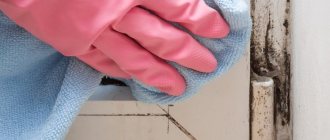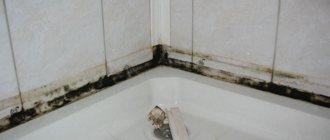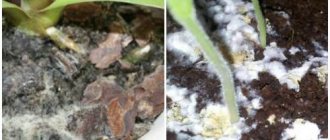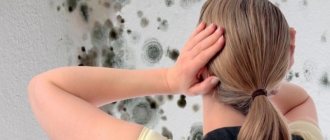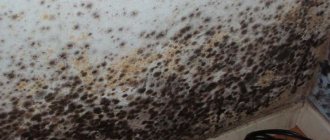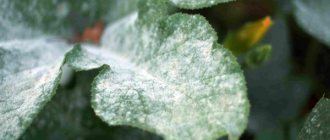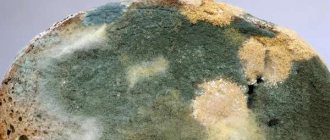Despite the obvious advantages of plastic windows, they have very serious disadvantages that can negatively affect the entire house as a whole. Fungus and mold can form on the window, which can then spread to other areas (which is especially dangerous for wooden structures).
PVC windows “go moldy” for a reason, there are reasons for this. For example, this problem often arises due to freezing of windows, which is important for the winter and late autumn period. The windows simply “sweat” from the inside, which leads to the appearance of condensation, the accumulation of which leads to the appearance of fungus and mold.
Fungus and mold on windows: the main reasons for their appearance on plastic and wooden frames and slopes
The main factors why fungus and mold appear on windows and slopes:
- High humidity. In winter, the permissible norm is 30-40%. If the slopes and frames turn black, this indicates increased humidity of 60%. More often this problem occurs in the kitchen and bathroom, where there is a lot of moisture evaporation.
- High room temperature. In order for mold spores to “feel good” and actively reproduce, the air temperature should be 15-38 C°. The most optimal is 22-27 C°. Therefore, the recommended norm during the heating season for humans is 20-22 C°.
- Lack of ventilation. Plastic structures do not “breathe” and do not allow air to pass through, like wooden windows. The natural circulation of oxygen is blocked. Wood provides micro-ventilation. But if the residents of a house or apartment rarely ventilate the room, even if they have wooden windows, then this greatly increases the formation of mold on the slopes and along the perimeter of the window frame.
Important: All cracks, chips on wooden frames, gaps in joints or seams, as well as poor sealing of the glass unit allow cold air to pass through. And when it combines with the warm flow, condensation forms. And puddles on the window are an ideal place for mold.
The cracks create constant drafts
Preventive actions
To avoid the reappearance of mold on plastic windows and other surfaces, be sure to ensure good air circulation in the room. It will be necessary to establish a ventilation system, as well as remove all sources of moisture - indoor flowers that require regular watering, containers with water, wet laundry. And, of course, you need to repair the heating system if even a minor leak is discovered. Only by eliminating all negative factors can you count on long-term results.
Rate this post
Fungus and mold on windows: additional causes of condensation
Let us repeat that constant moisture on windows leads to the growth of fungal spores. Plastic windows are more susceptible to this due to the tightness of the frame itself. But it is worth highlighting the reasons that many overlook, and they apply to any windows.
Additional reasons why fungus and mold appear on windows:
- Incorrect installation or assembly of the structure itself. That is, if there are cracks or emptiness between the frame and the wall, then there will be a constant draft in the house
- Insufficient layer of polyurethane foam. Or has it dried out over time?
- If the cleaning was initially done poorly and the foam did not stick well
- When the window sill is not used and water accumulates under the frame
- Distortion of the frame itself due to insufficient use of dowels or too wide a distance to the slopes
- If the window was installed directly on the insulation without wedges
- Gaps or cracks in the wall
- The window sill and slopes are too wide. A large window sill blocks the circulation of warm air from the radiators in order to properly dry the window from condensation
- Insufficient radiator/heating radiator
- The curtains are too thick, which also blocks the air to the window
A large number of flowers increases humidity and interferes with circulation
Common causes of mold
Signs of mold are visible to the naked eye. There are many reasons for the appearance of dots and stains on plastic. Let's look at the most common ones:
- Air exchange is disrupted, poor ventilation. The windows, made of wood, had natural gaps. Due to this, air circulation was carried out. Regardless of ventilation. The humidity in the room was normal. The accumulation of vapors in the air leads to increased humidity. Plastic windows prevent oxygen circulation. They close tightly. The drafts have disappeared. Consequently, the humidity level became higher.
- The advantage of plastic is its tightness. It is one of the conditions conducive to the rapid spread of the fungus. Namely, heat and humidity are the two main factors. They are the ones who contribute to its appearance.
Attention! Plastic windows stop natural air exchange. Their incorrect installation contributes to the accumulation of condensation on slopes, window sills, and frames.
Fungus and mold on windows: control methods
You need to remove fungus and mold on windows according to the following scheme:
- Carry out a thorough cleaning of mold spores by washing
- If the fungus is very ingrained, you should use a brush, sandpaper, spatula or any sharp object. It is important to remove all deep stains, loose putty or damaged wallpaper.
- Dry the surface
- Use antifungal drugs or fungicides (list below)
- Some chemical solutions require that they be washed off with clean water. Therefore, read the instructions
- Dry the entire window area well with a building/household hairdryer, selecting a warm mode or another heating device
- If the mold is very “ingrained”, then the procedure can be repeated 2-3 times
- Waterproof the window frame - seal all seams and joints. Wooden windows can be covered with paper or cloth. But now you can use window sealant (acrylic, silicone, semi-sulfide, polyurethane) or special tape for both plastic and wooden frames.
Tip: Finally, you can diffuse a water solution of antiseptic essential oils, such as tea tree, clove, lavender or orange, grapefruit. But keep in mind - oils do not dissolve in water! First, 5-6 drops must be dissolved in 1 tbsp. l. alcohol and then mix with 100 ml of water. The proportions can be adjusted depending on the surface to be treated and the desired intensity of the solution.
Wipe off the mold thoroughly
How to remove mold from windows?
In order to remove black mold stains from plastic surfaces, you can use folk or industrial remedies. It won't be that difficult to do. The most important thing during such cleaning is to take into account what material the profile is made of and not to use too aggressive chemicals in the fight against mold.
Traditional methods
The choice here is quite wide:
- 9% vinegar works great against mold. Apply it (without diluting) to the affected area for one hour and then rinse with water.
- Baking soda and hydrogen peroxide can remove mold from a white profile (it is better not to use this method for colored people, as peroxide can affect the brightness of the color). Mix soda with water and apply the resulting slurry to the surface to be cleaned. Spray hydrogen peroxide from a spray bottle on top. After the reaction stops, wipe the profile with a clean damp cloth.
- Another way to use soda in the fight against mold is to prepare a solution based on it (you will need 4 tablespoons for one liter of water) and rinse mold-affected surfaces with it.
- Tea tree oil is an effective antiseptic. Prepare such a solution - mix one teaspoon of salt and oil, add one glass of water to them and mix thoroughly until the salt is completely dissolved. Wash all surfaces of the window with the resulting product. There is no need to wash it off, since this product not only destroys mold, but also has a preventive effect.
- Another method is not as safe as the previous ones. Copper sulfate is used here in combination with bleach. You should work with these drugs in a well-ventilated room, after wearing rubber gloves. Add 100 ml of bleach and copper sulfate to one liter of water. Treat the mold with the resulting solution, and after 5 minutes, rinse the affected area with water.
After the mold has been washed off the windows, all surfaces must be thoroughly dried. To do this, wipe them with a dry cloth or open a window to allow excess moisture to evaporate. You can even use a hairdryer to dry the plastic parts of the window.
Try not to use abrasive powders, as well as industrial chemicals containing acids and chlorine to combat mold on PVC windows. They can negatively affect the quality of the plastic. If you want to purchase a special product designed to combat mold, you can opt for “Well Done” , “Domestos”, “Vanish” and some others.
If mold appears on slopes painted with water-based paint, you should not wash them. In this case, it is better to use a brush or a UV lamp.
Fungus and mold on windows and slopes: how to remove?
You can simply wipe off the fungus and mold on the windows, but on the slopes this is not enough. Firstly, it is not so easy to remove, and secondly, you need to fight the cause, not the consequences! Otherwise, disputes will return again, capturing new territories.
- It is necessary to completely dismantle the slopes and remove the window sill
- Thoroughly wash the entire area, treat with antiseptic preparations based on chlorine or biocide
- Fill large gaps with polystyrene foam and blow out cracks with foam. Don't forget to trim off any excess frozen areas. To guarantee, apply sealant
- Return all parts to their place. Putty the slopes, paint or cover them with the desired materials (plasterboard, plastic or MDF panels)
- Slopes can be waterproofed with a special mastic that does not allow moisture to pass through and protects against the proliferation of fungal spores. You can also use sealant or tape
Seal all the cracks!
Tools and preparations for work
To get rid of mold on slopes, you will need special preparations that are used to treat the surface. For this purpose use:
- solutions with antifungal action;
- detergents containing chlorine.
To protect the skin on your hands and respiratory organs from exposure to aggressive components, wear rubber gloves and a mask. If the fungus has eaten deeply, you have to dismantle the slope. This cannot be done without special tools. Therefore, additionally prepare:
- spatula, drill and chisel;
- heat-insulating material;
- screwdriver, tape measure or ruler;
- means for sealing seams and joints;
- new plastic panel;
- special glue for plastic, sharp knife.
How to remove fungus and mold on windows: a review of the best chemicals
You can buy a product to remove mold and mildew from windows at any hardware store. Moreover, they are suitable for working on any surface - concrete, brick, plasterboard, plaster or paint, ceramics, stone or wood. We offer a list of the best anti-mold drugs:
- Olympus stop mold
- Metas- BIO
- Tex
- NANO-FIX
- Abedis 06
- Fongifluid Alpa
- SCHIMMEL-ENTFERNER
- Dali
- Dufa
- Vincents Polyline
Review
You should be careful with plastic windows - against strong agents, and with prolonged exposure, the plastic may turn yellow. Therefore, it is better to choose the following means, since they are less aggressive:
- NEOMID Bio
- Biotsid-S
- Mellrud
- Tilex
- HG
Important : Take precautions, cover your eyes, head and hands! And always follow the instructions! Before purchasing, find out the degree of toxicity of the drug, whether it can be used indoors or on a certain surface, and how it affects animals.
Typically, chemicals are sprayed and removed along with the mold. If necessary, the procedure should be repeated to remove mold to the base. Then an antifungal primer is applied.
Treat every area
Rules to prevent mold growth
To prevent mold, there are several important rules you need to follow. Do not block ventilation openings in the kitchen and bedrooms. Closing them leads to disruption of air exchange. Do not place furniture close to the wall.
Periodically check the condition of plastic windows. Serviceability of fittings. Replace tires if necessary. Check the slopes for cracks. It is better to fix any damage immediately.
Do not fill the windowsill with indoor flowers. They cause increased humidity. And humidity is the best environment for fungus to appear. Do not keep interior doors closed. The air temperature in the house should be uniform. Therefore, the humidity level will be even. Do not dry washed clothes in a small room.
How to remove fungus and mold on windows and slopes: folk remedies
Available medications will also help to combat fungus and mold on windows, slopes and even walls. We highlight the most effective:
- Whiteness/bleach – diluted in a ratio of 1:10. Using gloves, wipe all areas; no need to rinse. Please note that chlorine lightens some materials!
- Domestos – has a rather aggressive smell. Dilute 1:100, no need to rinse. It is worth wiping 2-3 times a week, for 2-3 weeks and for preventive purposes.
- Copper sulfate - dilute 1 to 100 with water. Those. for 1 liter only 10 g of vitriol. Work only with good ventilation and wearing a respirator. May give a bluish color to some materials, no need to rinse off
- Borax – dilute in a ratio of 1:10. Absolutely safe for humans! No need to rinse
- Soda is another safe remedy. Dilute 1 tsp. in 200 ml of water, thoroughly rinse all infected areas. No need to rinse
Folk remedy
- Hydrogen peroxide 3% - no need to dilute. It is necessary to spray and leave for 10 minutes to soak. Remove along with mold and rinse with clean water
- Peroxide and soda - mixed until it becomes a paste. Apply a thick layer for 30 minutes and wash off with clean water.
- Ammonia – dilute in a 1:1 ratio. Wash off after 4 hours. It has a very pungent smell!
Important: Never mix ammonia with chlorine-containing substances! The chemical reaction provokes the release of a very harmful gas.
- Vinegar – used undiluted, washed off 1 hour after application with clean water
- Soap solution made from laundry soap 72%. For severe damage, soap will not help, but it is an excellent and safe prevention of mold on windows or in other areas of the house! It is enough to dissolve a small piece of soap in water and clean in high-risk areas.
Proportions
Step by step solution to the problem
You need to understand that mold on plastic windows is not enough to simply wash off. Solving the problem must be approached comprehensively, otherwise there is a risk that the fungus will soon return again. To prevent this from happening, we must call on all available methods and means to help.
Eliminate the root cause
The fight against mold should always begin with eliminating the root cause - the source of high humidity. Otherwise, all efforts will be in vain, and the fungus will appear with enviable regularity.
First of all, it is necessary to determine why the windows become moldy and carefully evaluate their condition. If condensation regularly forms on them, the installation was carried out in violation of the process technology. Poor installation leads to deformation and displacement of the frame, errors in measurements lead to insufficient thermal insulation. Constant humidity is an ideal environment for fungi and other microorganisms, so if the source of dampness is not eliminated, it will not be possible to completely get rid of mold on windows. The best option in this case is to replace or reinstall double-glazed windows.
If during the inspection of the window no defects are identified, the problem is in the room itself. If the humidity level in the room exceeds 60%, it is necessary to immediately reduce the levels and establish air exchange.
Cleaning stains
After the source of dampness has been eliminated, you can begin to remove mold stains from the surface of window frames, window sills and slopes. This must be done carefully, without missing a single centimeter, since the spores are very tenacious and love secluded places. Superficial treatment will not save the situation - the fungus will grow again.
The most difficult thing to eliminate is mold that has formed on window slopes. As a rule, they are made of plasterboard - a porous material that turns into a real breeding ground for pathogenic microorganisms. In this case, there is no alternative; a complete replacement of the finishing sheets will be required, followed by treating the wall surface with special antifungal compounds. The exception is plastic slopes - they can be washed using the same means as the rest of the window parts.
You can remove black stains using accessible and inexpensive household chemicals. They can be found at any hardware store. The main thing to remember is that these substances are quite aggressive, so you need to take precautions when working with them. Among the most effective are:
- Chlorine-containing preparations. They help both get rid of mold on the windowsill and window frame, and disinfect the room. They should be diluted with water in a ratio of 1:5, after which the mold should be thoroughly washed with a sponge soaked in the solution. When working with bleach, you must protect your hands with gloves and use a respirator.
- Copper sulfate is an effective remedy that can be found in gardening shops and supermarkets. With its help, it is easy to wash even extensive stains; you just need to apply it to a sponge and wipe the surface affected by the fungus. As in the case of bleach, you should protect your hands and respiratory tract from contact with the substance, and the room should be thoroughly ventilated.
- Baking soda is a remedy that does not give the fungus a single chance. You will need to mix 100 g of powder with 300 ml of water, stir thoroughly, then apply the solution to the stain using a sponge and wipe.
- Table vinegar will also help get rid of mold on windows. First, you need to wipe the stains with a dry cloth, and then apply undiluted vinegar to them. After two hours, surfaces should be rinsed with clean water. If the contamination cannot be removed the first time, the procedure can be repeated.
Cleaners such as Dufa, Vincents and Polyline are not recommended as PVC will turn yellow on contact with them.
How to prevent fungus and mold on windows and slopes: preventive measures, tips
To prevent mold and mildew on windows from bothering you in the future, follow some rules. But most importantly, watch the humidity level! Otherwise, all mold control will be ineffective.
- If possible, do not dry things in the house, as they greatly increase the humidity. You will learn what the danger is and how to dry clothes indoors in our next article “Why is it dangerous and how to properly dry different things in an apartment/house?”
- Ventilate regularly! Preferably 2 times a day for at least 15 minutes. If you have no other choice but to dry things indoors, then ventilate more often and more - at least 3 times for 30 minutes
- In the kitchen, while cooking, turn on the hood or open a window for micro-ventilation
- In the bathroom, turn on the hood or leave the door open for a while after bathing
- Use an air dehumidifier, an ozonizer or a quartz lamp, and place an odor absorber (sorbents in the form of tiny balls) on the windowsill. Alternatively, you can turn on the heat fan - it will also dry the air
- Check the ventilation system, it may need to be cleaned or repaired
- If you have a wide window sill, install special grilles or make a series of holes at the level of the radiator so that warm air reaches the windows
Create air circulation in the windowsill
- It would not hurt to install ventilation valves or microclimate systems in plastic windows, which will independently normalize the microclimate in the house
- Any leaks in the house also increase humidity. Eliminate them on time
- Prevent mold from growing in flower pots. A large amount of it also increases the humidity in the house and blocks normal air circulation to the window. Violet and geranium promote mold growth
- Wipe off condensation immediately!
- Monitor the condition of windows and the operation of mechanisms
- Immediately repair any cracks and holes in the walls and ceilings
- Keep your windows clean regularly
- Once a month, carry out preventive cleaning using chemicals or folk remedies
- Open curtains more often and choose them only from natural materials
- If interior doors are installed, open them more often so that air can move freely throughout the apartment/house
Risk factors
There are several reasons why mold appears on plastic windows:
- The installation of double-glazed windows was carried out in violation of technology.
- High level of humidity in the room.
- Lack of ventilation.
- The presence of a wide window sill, which impedes the movement of warm air currents tending to the window.
- Insufficient thermal insulation of the walls of the house.
These and other factors provoke the development of fungus on windows, providing favorable conditions for the active growth and activity of microorganisms. It should be borne in mind that at the initial stage the problem may not have visual manifestations. Even before brown, green and black spots appear on the windowsill and slopes, a characteristic musty smell appears in the room, which no air freshener can cope with.
Antiseptic treatment
Since mold can form on different surfaces (slope, window frame, glass, walls, etc.), modern antiseptic substances, which can be selected according to the structure and type of damaged surface, will help to remove it. Such products can be purchased at a hardware or construction store, or you can make them yourself.
Of course, the store will provide you with qualified assistance in choosing the right product in terms of price/quality, but in order to save money, you can try preparing the solution yourself. A solution based on vinegar and boric acid. To prepare you will need:
- 200ml vinegar (70%).
- 200 ml boric acid.
- 1 liter of water.
- A solution of sodium fluoride and copper sulfate.
Boric acid 3%
For the cleanser you will need:
- 100ml sodium fluoride.
- 100 ml of copper sulfate.
- 1 liter of water.
Note! Antiseptic agents must be used to treat absolutely the entire surface of the “infected” window: the one from which the mold was removed, as well as those places that were not affected. You will ask why?". The fungus may appear again and the wall will begin to mold so much that it will require the installation of not only new slopes, but also a complete replacement of the entire window profile.
How to clean a surface from mold?
Treatment of windows against mold
How to remove mold from a plastic window, slopes and window sill largely depends on the finishing material. If the slopes, like the window frame itself, are made of plastic, the fight against the “window pest” will not be effective unless the panels are dismantled and the walls are disinfected. If the slopes are made of sheets of plasterboard, it will need to be completely removed and new sheets installed, because it is not possible to wash off the mold that has penetrated deep into the material.
But, before treating the surface of the window with an antifungal agent, you will have to get rid of the mold with a brush and with your own hands. Fungus will not appear in the future only on a window that has been thoroughly cleaned and only then treated with a special product. After cleaning and treating the window surface is completed, you will need to ventilate the room.
Methods for combating mold and condensation on windows (video)
Prevention
Before you start fighting mold, it is necessary to identify the causes and sources of its occurrence. Removing an existing fungal colony will not protect windows from the re-growth of microorganisms. Eliminating the causes and further prevention will help you forget about the problem for a long time.
Removing plaque does not guarantee that mold will not grow again. For prevention, several rules should be followed:
- monitor the temperature, maintain the humidity level up to 60%;
- regularly ventilate rooms;
- wipe away dust and water;
- install a ventilation system and monitor its serviceability;
- remove sources of high humidity and objects from the windowsill (houseplants, aquariums, drying clothes);
- choose the right curtains.
When choosing and installing windows, it is important to pay attention to the following points:
- Select the window design according to the natural and climatic conditions of the place of residence.
- Replace during warm and dry seasons.
- After removing construction debris, carefully treat the window opening with antiseptic agents (primer, solutions).
- After installing the structure, generously fill all cracks with foam, and use sealant if necessary.
- Choose window sills with a width that will not block the flow of heat from the radiator (the best option is that the width of the board covers half of the heating device).
In the event that fungus appears due to improper installation, work should be carried out to clean and insulate the window structures. Often, after removing the fungus, a specific damp smell remains in the apartment. To get rid of it, you can use drugs that absorb odor, place charcoal in the corners of the room, and ventilate the room.
How to fight mold on the slopes of plastic windows
How to get rid of mold on plastic windows
We clean windows in the off-season, but sometimes there is a need for additional procedures. For example, if you notice that mold has begun to appear on your plastic double-glazed windows.
Of course, you need to get rid of the fungus, and then eliminate the cause of its occurrence, if possible. Today we will tell you exactly how to deal with traces of mold on plastic windows in the house, how to remove it from slopes and window sills, and what should be done.
It's better not to let the windows get into this state.
There are a number of ways to save on utility bills.
- How to legally save up to 60% water in a month .
- How to pay 2 times less for electricity .
- How to reduce gas consumption by 40% .
Input data
The use of plastic windows has long become widespread. They are convenient and practical, they do their job perfectly, they close hermetically, save us from the cold, noise from the streets, and bring comfort and coziness into the house. In addition, from an aesthetic point of view, they look much more impressive than any painted wooden frames.
By the way, there is no need to paint double-glazed windows either; they hold their color well and practically do not fade. To bring them back to normal condition, it is enough to simply wash them from time to time.
All these excellent qualities of double-glazed windows are preserved with proper installation, but if miscalculations and mistakes were made in this process, then problems may arise. The most common problem is high humidity, and as a result the formation of fungus and mold.
Unlike wooden windows, which are not so airtight because they have large gaps in their design through which moisture escapes, plastic windows close tightly, completely blocking fresh air. It is the main advantage of double-glazed windows that in this case becomes the main disadvantage, generating condensation indoors.
Double-glazed windows allow you to create a comfortable microclimate at home
A warm, humid environment is perfect for mold, so it happily takes up residence there. This microscopic fungus causes a lot of trouble and leads to the destruction of building materials. Builders call mold a biodestructor, since most construction problems result in the fight against this fungus, and it does not spare materials.
In addition, mold has a negative impact on human health. Spores of microorganisms enter the humid indoor air that we breathe, and as a result, severe allergies or other diseases, such as mycoses, can develop.
Window care
However, with normal care and constant attention, even problematic windows can be kept clean and tidy. To do this you need the following:
- constantly carry out cleaning activities to remove dust;
- install air conditioning systems in the house, check general ventilation;
- Eliminate sources of moisture and dampness in the room. distribute indoor plants around the house, dry clothes in designated areas, quickly resolve issues with pipe leaks, wash with a limited amount of water;
- excellent atmospheric indicators for the room: temperature around +22°C, humidity no more than 60%.
Note that mold from old windows can migrate to new ones, so when preparing to install double-glazed windows, it is necessary to take drastic measures to destroy the fungus.
After dismantling the old windows, it is necessary to clean the window opening, remove all traces of organic materials and dirt. Particular attention should be paid to the area under the windowsill near the radiator, a favorite place for mold. After removing the stains, it is highly recommended to treat the window opening with mold-fighting agents called fungicides. With this approach, even high humidity in the room may not lead to mold on the windows, slopes, or windowsills.
Ventilate your apartment regularly
If time is lost and mold appears, then you need to start eliminating it. A whole range of measures will help us get rid of fungus and mold for a long time, from mechanical removal to chemical treatment.
- To destroy the source of mold, you first need to physically remove the fungus, then heat treat the site of occurrence using hot air, such as a hairdryer. If you have UV irradiators lying around at home, you can additionally irradiate the fungus.
- After mechanical work, it is imperative to treat the areas where mold appears with chemicals. It is acceptable to use a chlorine-containing detergent, but it is best to use special fungicides, which we will discuss later. Treatment with such compounds will allow you to get rid of the fungus for a long time, for several years. In addition, fungicides have cleaning effects, so in addition you will remove dirt from frames, slopes, and window sills.
Among the most popular means for combating mold, the following compositions can be distinguished:
- Bleach is the simplest and cheapest remedy, in addition to fungus, it kills bacteria and disinfects space. Bleach is diluted with water in a ratio of one to five. To work with this chemical, wear gloves and a respirator. Bleach kills mold instantly, so it makes no sense to apply it for a long time. It can negatively affect the decorative component of your window, so it is better not to use it for the front parts of plastic frames, slopes, and window sills.
- Poisonous copper sulfate perfectly destroys all microorganisms. When using it, you must wear rubber gloves, and a respirator is also necessary. Copper sulfate is suitable for processing frames and slopes made of plastic; it cannot be applied to metal parts, as it causes corrosion.
- It is permissible to mix copper sulfate and bleach to create an ultra-aggressive mixture. The drugs are combined in equal proportions: for 1 liter of clean water, 100 ml of bleach and 100 ml of copper sulfate.
- Household fungicides are most often created on the basis of the same bleach and copper sulfate, but are presented in finished form. You can use the composition from the domestic brand "Tex". If you want to use a more gentle product, take regular Whiteness.
Domestic fungicide against mold
To remove mold from the front parts of the window, the above methods are not suitable, since they can spoil the color, giving it a yellow tint. Therefore, for cleaning we will use more gentle household chemicals:
- The vinegar solution is created from 1 liter of water, 200 ml of vinegar and 200 ml of boric acid. You can use it to wipe off fungus from glass and plastic frames.
- Tea tree oil, diluted in a ratio of 1 teaspoon per 250 ml of water, works well against fungus and is a natural substance.
- A 3% solution of hydrogen peroxide, you don’t even need to mix it with anything, you can immediately remove mold on plastic windows with it.
- It is acceptable to use detergents to remove mold from ceramic tiles; they are quite gentle, for example, Cillit Bang.
- Disinfectants perform excellent in the field of cleaning fungus from plastic windows: Biocide, Neomid.
- In city pharmacies you can find antifungal compounds: Candide, Clotrimazole.
To make it easier for you to navigate when and how to start fighting mold, follow the simple instructions below.
Mold control tactics
The first sign that mold may appear on your plastic windows in the near future will be condensation on the glass. Increased humidity and heat will be an excellent catalyst for the growth of fungus, and it will start from the dampest places.
Condensation inside the glass unit
Therefore, at the very beginning, mold will appear in the corners of the windows, where condensation flows, and we will carefully inspect them. If you find blackheads in these areas, congratulations, you are starting to develop mold. It is worth immediately starting to remove it so that it does not spread to all windows, slopes, and window sills.
The work ahead is hard, so get ready:
- Wearing rubber gloves, prepare a bleach solution and treat the area where the fungus appears. Along the way, it is worth carefully examining the degree of mold damage to the window, where the black spots have spread.
- If you see that mold is present not only on the windows, but also on the slopes, whether they are made of plastic or drywall, you will have to dismantle them. Having disassembled the window opening, you need to fill all the voids and defects of the wall with foam. Then wait until it dries, trim, put the slopes back and apply sealants to all joints. After which, paint, if required.
- After removing mold from the windows, you can additionally treat them for preventive purposes using the Anti-Mold product and leave them to soak in for a couple of days. After a couple of days, the window must be washed with clean water, without using detergents.
This is the picture that can await you under the slopes
To completely remove mold from a window, it is necessary to maintain a comfortable temperature in the room of twenty degrees and a minimum humidity of no more than 30%. To determine humidity, buy a hygrometer. Ventilating the room will help get rid of excess moisture; if condensation forms on the glass, it must be removed immediately.
Note that condensation can form on the window if the window sills underneath are too wide, blocking warm air from the radiators below.
Especially in the off-season, when the batteries do not work, poor air circulation has a very strong effect on the windows. Therefore, if you think that the window sill is too wide, you can shorten it, or cut holes to access warm air. In this case, special metal grilles can be installed on the batteries, allowing you to control the flow of warm air and direct them to the right place.
If such measures do not lead to the desired result, but something needs to be done, then, as an experiment, you can install special ventilation valves on the windows, which will operate when the humidity in the room increases. They regulate the opening and closing of the window, and provide air intake from the street, thereby affecting the overall humidity in the room.
If the room is prone to high humidity, only a full-fledged ventilation system will help correct the situation. In such a room, even an air conditioner with a fungicidal air filter will not save you from the formation of fungus.
As you can see, there are no particular difficulties in the fight against mold and mildew; the most important thing is to establish a good microclimate in the room and proper ventilation. In this case, even with incorrectly installed windows, you can exist without mold. Ventilate the room regularly and let in fresh outside air. If mold fungus still appears, immediately prepare yourself for a long struggle, the result of which you will achieve with perseverance.
Mold on plastic windows and slopes, how to fight?
Mold spores accompany us everywhere. They cannot be detected with the naked eye; they float in the air, waiting for a favorable environment for their reproduction to appear. A couple of fungi can appear in the most unexpected places, for example, on your windows.
In the summer, this problem is not so noticeable, but as soon as the heating season begins and we close the windows tightly before the onset of warm spring days, the first spots of mold may appear on the slopes, the window sill and the frame itself. Why does mold appear on plastic windows and slopes, how to deal with this problem?
Causes of mold
Before you start fighting the fungus, you must first get rid of the main cause of its occurrence - moisture.
Have you noticed some inconsistency? The main cause of fungus is humidity, but the heating season begins in winter, radiators and heaters dry out the air greatly and there can be no talk of any increased humidity.
The appearance of mold in winter is no coincidence. The fungus needs a moist and warm environment; having found a secluded place with comfortable conditions, it begins to quietly develop and grow. You may not notice it for months. If the window is poorly waterproofed, moisture from the street can enter the room, under the slopes, or inside the profile. It is there that the fungus finds its first refuge. When the heating season begins, summer moisture becomes insufficient for the fungus and it comes out of its hiding place in search of new feeding. So mold most likely appeared a long time ago, but you will notice it only in winter.
How to get rid of mold on windows?
Visible traces of fungus can be removed with improvised means: bleach, ammonia and ordinary detergents. In this way you will not kill the mold, but will only “spoil its life” a little.
Do not forget that we see only a small part of the problem; mold on plastic windows can sit deep inside and at the first convenient opportunity the stains will appear again.
The fight against mold should take place in several stages; this is the only way you can be completely confident that you have defeated it completely and irrevocably.
First stage: clean the surface
As a rule, it is slopes that are the source of mold. If the side surfaces of your window opening are decorated with plastic panels and characteristic stains appear on them, rest assured that an even bigger problem is hidden under the plastic.
Therefore, it is recommended to remove the decorative lining of the slopes and disinfect the walls first. If the slopes are finished with plasterboard, it is best to replace them completely: most likely the mold has penetrated deep into the material.
Using a stiff brush, remove visible mold from plastic windows and slopes.
Treat problem areas with an aqueous solution of household bleach in a 5/1 ratio.
Don't forget to wear gloves and a respirator mask: bleach will cause a burning sensation if it comes into contact with your skin.
After this stage, the room must be ventilated.
Second stage: we treat the slopes with antifungal compounds
You can purchase a ready-made antifungal mixture at a hardware store. They are liquid formulations with a high content of fungicidal additives (fungicides are chemical substances designed to fight fungi). In most of these products, chlorine is the main component, along with various additives that significantly improve its effect. In more gentle compositions, copper sulfate is used. As a rule, such compositions are sold in convenient packaging with a spray bottle. The most well-known brands producing such products are TEX, Dufa, Vincents Polyline.
What to do if you urgently need to remove mold on plastic windows and slopes, how to fight it? In this case, there is most likely no time to choose an antifungal agent. Then you can prepare it yourself, spending a minimum of money and time. In some cases, these home remedies are even more effective than those you can buy.
Antifungal compounds at home:
1) 0.2 liters of acetic acid (70%), 0.2 liters of boric acid, 1 liter of water;
2) 0.1 l of sodium fluoride, 0.1 l of copper sulfate, 1 l of water;
3) 0.1 l of copper sulfate, 0.1 l of household bleach, 1 l of water.
Sodium fluoride and copper sulfate can be purchased at hardware stores or where various gardening chemicals are sold.
The finished mixture is applied to the entire area of the slopes using a synthetic brush. Don't forget to wear gloves and a respirator mask. After treating the entire surface, it is necessary to thoroughly ventilate the room for 30-40 minutes.
Third stage: consolidate the result
Don't stop there. In order to prevent mold from appearing on plastic windows again, it is necessary to use waterproofing agents.
A rubber-based mastic or primer is ideal as a waterproofing agent; they will cover the wall with a waterproof, dense film that will last for many years.
Applying such products should be done with a large silicone brush. It will take a few more hours for this “shell” to dry.
Mold prevention
The best defense is an attack, and the best way to get rid of mold on the slopes of a plastic window is prevention.
Follow these rules and you can be sure that the hated mold stains will not appear again:
1) Maintain an optimal level of indoor air humidity. Ventilate the room periodically at any time of the year.
2) Make sure your windows are moisture resistant and thermally insulated. Check the suitability of the plastic seals on the sash and double-glazed windows at least once a year. Change them if necessary.
3) Once every few years, treat potential areas where fungus occurs with fungicidal compounds. When renovating an apartment, do not forget about additional measures for protection against mold and proper waterproofing.
4) If condensation (fogging) occurs on the glass, check all possible causes for its occurrence and try to get rid of this problem as soon as possible. Condensation is the first warning sign. You can read more about this in the article “Why do plastic windows sweat? "
By following these recommendations, you can no longer worry about mold on plastic windows and slopes.
Mold on the slopes of plastic windows - how to fight?
You have installed new plastic windows in your apartment. but they soon noticed that the window slopes were covered with a black coating. This is mold. which is a strong allergen that can cause respiratory tract diseases that are dangerous to humans. In addition, such mold can even destroy the material from which the house is built. Anxious owners of such apartments are interested in the question: how to deal with mold on the slopes of plastic windows.
Why does mold appear on windows?
The main reason why black mold appears on windows is the increased humidity in the apartment. After all, the plastic from which modern windows are made does not allow moisture to pass through or evaporate at all, unlike, for example, wood. In addition, mold can also occur due to poor air circulation in the room.
Another reason for the appearance of mold is poor-quality window installation, which results in a violation of its tightness. At the same time, moisture stagnates in the room, which leads to the appearance of mold on windows and walls.
Remedies for mold on windows
First, you should try to remove mold from slopes using various means. The easiest way to remove mold is with a sponge soaked in hydrogen peroxide, vinegar, ammonia, bleach, or any detergent.
To combat mold, you can use industrial fungicidal agents that have an antifungal effect. They are most often made on the basis of chlorine, and various additives help enhance its effect. There are products based on copper sulfate. Carry out the treatment in a respirator and rubber gloves, and after work, ventilate the room for half an hour.
If you simply remove the mold, it may soon appear again. Therefore, to combat it, it is necessary to eliminate the reasons why mold arose. Window slopes must be treated with waterproofing agents. In addition, the room must be regularly ventilated, and the tightness of the double-glazed windows must be monitored.
- Mold on the slopes of plastic windows, what to do? Mold on the slopes of plastic windows - how to fight? You have installed new plastic windows in your apartment.…
- Rules for choosing modern plastic windows Windows must be of the highest quality and safest possible. This is due to the fact that profiles...
- Photos of plastic balconies Recently, finishing balconies with plastic panels has become very popular. In addition, while renovating the balcony...
- Sandwich panels for slopes of plastic windows Everything about window sandwich panels: installation, characteristics and dimensions When replacing windows, you always want to perform installation…
